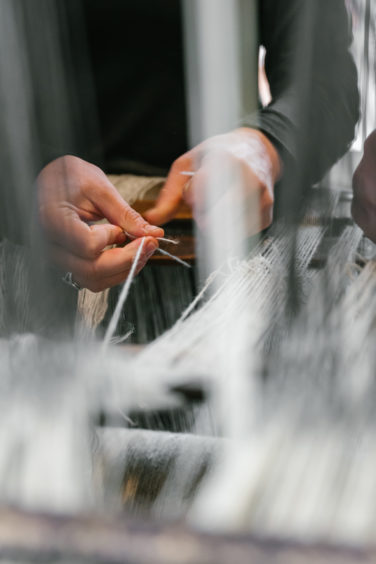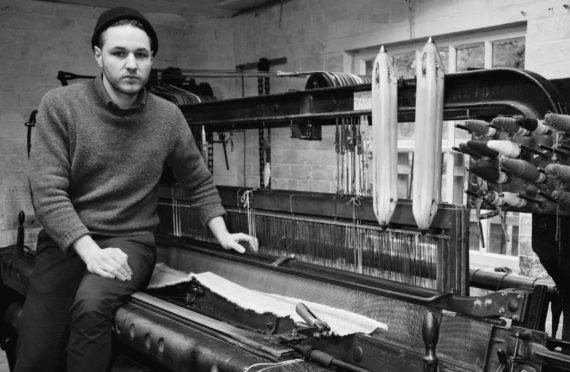“Imagine the most noisy, grabby, murderous machines you can think of,” said expert cloth weaver Daniel Harris.
“And they’re throwing a shuttle back and forth 80 times a minute with metal spikes coming out from all angles and big belts coming down from the ceiling.”
It’s not a traditional portrayal of an antique Victorian Dobcross loom, but once they are in full flight, Daniel’s description makes more sense.
Hungrily consuming yards of freshly spun yarn, the old looms’ hundreds of intricate moving pieces rattle and clatter noisily, shuddering and shaking as they produce fabric in a way which hasn’t changed for more than 100 years.
Built during Queen Victoria’s reign, the machines at the Knockando Woolmill near Aberlour have been the lifeblood of this community for generations.
Now, they are the only working looms of their kind in Europe.
 While others were replaced by new machinery or fell into disrepair, against the odds this duo have stood the test of time, tucked away down a single-track road in the heart of the Spey Valley.
While others were replaced by new machinery or fell into disrepair, against the odds this duo have stood the test of time, tucked away down a single-track road in the heart of the Spey Valley.
The remote location meant it was too much effort to remove their metal parts for the war effort. Miraculously they also survived a devastating flood and – the biggest threat of all – the arrival of modern technology.
“The history wrapped up in these machines is just incredible,” said Daniel, “for me, that’s more important than the products they produce.
“There has been a mill here in some form since 1784, and these two looms date back to 1896 and 1899 respectively.”
With well over a century of weaving under their belts, the 120-year-old looms, standing at two metres high and a hefty 2.5 tons apiece, have been lovingly coaxed back into full service by Daniel, a self-taught weaver and bona fida loom repair expert.
Primarily based in London running his own sustainable weaving company, Daniel was lured north by the rustic charm of Knockando when the mill’s owners appealed for some help in refurbishing their old machines.
“It’s a real dying art,” said Daniel. “There are only about 100 working looms left running in the country, so finding anyone who can work them, let alone repair them, is a challenge.
“The first loom I got I totally took it to pieces – I’m probably the only person in the UK to do that in the last 50 years.
“And even then it’s only because it wouldn’t fit through the door of my workshop.
 “After a couple of weeks of trying to build it back up I realised my original loom was missing some parts, so I had to buy another one and that’s kind of how my obsession started.
“After a couple of weeks of trying to build it back up I realised my original loom was missing some parts, so I had to buy another one and that’s kind of how my obsession started.
“I’ve got five working ones now at my mill, the London Cloth Company, though I’ve been through about 12 over the years to get various different parts.”
In the nine years his company has been producing fabric, Daniel has supplied materials to all sorts of big names, including designers such as Ralph Lauren and bespoke tailors on Savile Row.
It’s a far cry from the history of the mill at Knockando, which helped provide fabric to keep its Speyside community warm and blankets to the War Office for troops on the Western Front during the First World War.
But the heritage of somewhere like Knockando was what attracted Daniel to it in the first place.
“This mill is incredibly special,” he said. “It gives us a real window into the past and it’s so important to keep it running for generations to come.
“I’ve worked in lots of different mills around the UK and I can’t think of anywhere like this – even in rural Wales the small-scale mills are vanishing.”
The existence of these mills goes back to when the Scottish and Welsh weaving industries were built around small local mills in often isolated locations.
They would run two or three looms in a mill, compared to larger mills who might run 300.
It meant that these two or three individual looms were incredibly important to the local communities who relied on them.
“Today Knockando is one of the only places left where you can see the whole process – carding, spinning and weaving – all in the same way and on the same site that it has always been done,” Daniel said.
“And it’s all fully traceable, with the yarn coming from sheep just a few fields over.
“The public’s interest in sustainability has been growing over the last decade and I think this lockdown has reminded people how important local producers of all kinds are.
“That’s where the value is, and for me it’s priceless.”
Knockando Woolmill is currently closed to visitors for the duration of the lockdown. For more details and to access its online shop, visit kwc.co.uk
